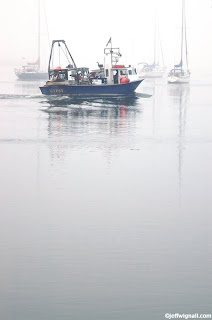 I'm a firm believer that every tiny bit of the frame should be working toward the benefit of the whole. If there is something in a frame that isn't working--try to get rid of it, either by cropping with your zoom lens or by changing your vantage point. But there are times when using empty areas, what artists call negative space can be a useful and provocative part of your compositions.
I'm a firm believer that every tiny bit of the frame should be working toward the benefit of the whole. If there is something in a frame that isn't working--try to get rid of it, either by cropping with your zoom lens or by changing your vantage point. But there are times when using empty areas, what artists call negative space can be a useful and provocative part of your compositions.There are actually three elements in any design: the positive space (that area where your subjects lives), the negative space (any substantial blank area in the frame) and the border. Your job is to create a pleasing interaction of these three elements.
Negative space can be used in a number of ways to help build a powerful composition. One way that negative space works is to simply create emphasis for the positive space (again, your subject). By photographing a horse on a hill with lots of sky behind it, for example, the eye naturally lands on the horse because it's the most interesting thing in the frame. Very importantly, blank areas in the frame can also be used to create a sense of balance. If you're photographing a tall ship in silhouette at sunset, for instance, you can balance the dark mass of the ship with a large bright area of sunset sky.
Yet another way that negative space can be exploited is to create a sense of distance and space. In the shot of the fishing boat, by using the negative space of the blank water so strongly at the bottom of the frame, it exaggerates the space between where I was standing and the boats. The eye can't help but travel up through the path of blank canvas and arrive at the boats. And by giving the eye such a long area to travel across, the brain has a better handle on the distances involved. You get a much better sense that I'm standing on the shore observing the boats.
Whenever you find an interesting object or subject to photograph, see if you can't find an area of relatively blank space--water, a lawn, sky, a big shadow--to help create a more interesting composition. Nothing can be a very powerful creative tool.






No comments:
Post a Comment